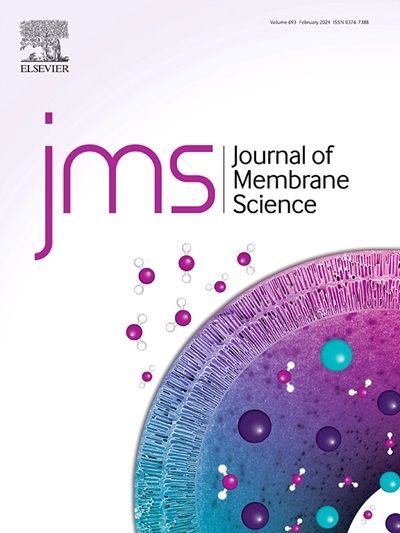Enhanced xylose/salt separation of nanofiltration membrane via a CTAB-assisted shedding strategy toward polyamide oligomers
IF 8.4
1区 工程技术
Q1 ENGINEERING, CHEMICAL
引用次数: 0
Abstract
Xylose is a small organic molecule with great economic value in fine chemical production. High-quality xylose production requires removing salt from the feed solution, which is typically an expensive process. Polyamide nanofiltration membranes, characterized by their high rejection of salts (e.g., Na2SO4) and low rejection of small organic molecules (such as xylose), are an effective separation technique. The present study proposes a CTAB-assisted shedding strategy toward polyamide oligomers to enhance the xylose/salt separation. When the membrane contacts CTAB solution at appropriate concentrations, CTAB aggregates adsorb onto the membrane surface due to electrostatic and hydrophobic interactions. The hydrophilic outer layer of these aggregates, attributed to the quaternary ammonium groups, facilitates the migration of polyamide oligomers into the solution, increasing membrane pore size and thereby decreasing xylose rejection. This mild process preserves the membrane structure and its strong negative charge, maintaining effective charge repulsion and ensuring high salt rejection. The increased pore size also enhances membrane flux. Results show that xylose rejection decreased from 44.2 % to 20.3 %, while Na2SO4 rejection remained above 98 %. The separation factor increased by 117 %, and flux increased by 104 %. Investigation of the shedding mechanism revealed that the variation of membrane flux with CTAB concentration aligns with the S-shaped adsorption isotherm model of surfactants at the solid-liquid interface. This suggests that the adsorption form of CTAB on the membrane surface is the dominant factor influencing this process. This work shows the promising potential of polyamide nanofiltration membrane technique for the xylose purification and the proposed strategy in small organic molecule/salt separation.

求助全文
约1分钟内获得全文
求助全文
来源期刊

Journal of Membrane Science
工程技术-高分子科学
CiteScore
17.10
自引率
17.90%
发文量
1031
审稿时长
2.5 months
期刊介绍:
The Journal of Membrane Science is a publication that focuses on membrane systems and is aimed at academic and industrial chemists, chemical engineers, materials scientists, and membranologists. It publishes original research and reviews on various aspects of membrane transport, membrane formation/structure, fouling, module/process design, and processes/applications. The journal primarily focuses on the structure, function, and performance of non-biological membranes but also includes papers that relate to biological membranes. The Journal of Membrane Science publishes Full Text Papers, State-of-the-Art Reviews, Letters to the Editor, and Perspectives.
 求助内容:
求助内容: 应助结果提醒方式:
应助结果提醒方式:


